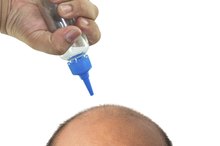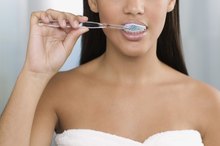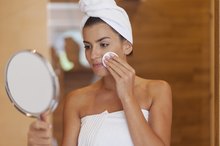How to Get Rid of Sebum
Sebum, a natural oil produced by oil glands in the skin, isn't a bad thing. In fact, sebum is a natural lubricant, keeping hair sleek and shiny and preventing skin from looking dry and wrinkled. Problems arise when the glands are overactive and produce too much sebum, states the University of Oklahoma Health Services 123. Excess sebum combined with dead skin cells, dirt and bacteria can cause clogged pores, blackheads and acne. Although different treatments will work for different people, you can try several useful methods for controlling excess sebum. See your physician or dermatologist if your condition doesn't improve.
Wash your face once or twice daily, when you get up in the morning and before you go to bed at night. Use warm water, a soft washcloth and a mild soap for oily skin. Avoid scrubbing, which can cause redness and irritation.
How to Treat Acne on a Bald Head
Learn More
Shampoo your hair daily, using a mild shampoo formulated for oily hair. Work up a lather as you massage the shampoo into your hair, then allow the lather to remain on your hair for five to seven minutes. Avoid conditioner, or apply conditioner only to the ends of your hair.
Use cotton balls or a mild astringent to dry up excess oils on your face. Dab your scalp with the astringent-soaked cotton balls.
Personal Hygiene Issues
Learn More
Use an over-the-counter skin product containing benzoyl peroxide, an antibacterial medication that will also help to dry the skin.
Select oil free cosmetics and skin-care products. Oil-free products will be marked "non-comedogenic" or "water-based."
Related Articles
References
- University of Oklahoma Health Services: Acne
- Health Services at Columbia University: Go Ask Alice!
- University of Michigan Health Services: Acne
- Fischer H, Fumicz J, Rossiter H, Napirei M, Buchberger M, Tschachler E, Eckhart L. Holocrine Secretion of Sebum Is a Unique DNase2-Dependent Mode of Programmed Cell Death. J Invest Dermatol. 2017;137(3):587-594. doi:10.1016/j.jid.2016.10.017
- Schneider M, Paus R. Sebocytes, multifaceted epithelial cells: lipid production and holocrine secretion. Int J Biochem Cell Biol. 2010;42(2):181-5. doi:10.1016/j.biocel.2010.11.017
- Bagatin E, de Freitas T, Machado M, Ribeiro B, Nunes S, da Rocha M. Adult female acne: a guide to clinical practice. An Bras Dermatol. 2019;94(1): 62–75. doi:10.1590%2Fabd1806-4841.20198203
- Picardo M, Ottaviani M, Camera E, Mastrofrancesco A. Sebaceous gland lipids. Dermatoendocrinol. 2009;1(2):68-71. doi:10.4161%2Fderm.1.2.8472
- Lovászi M, Szegedi A, Zouboulis C, Törőcsik D. Sebaceous-immunobiology is orchestrated by sebum lipids. Dermatoendocrinol. 2017;9(1):e1375636. doi:10.1080/19381980.2017.1375636
- Zhou S, Li D, Zhou Y, Cao J. The skin function: a factor of anti-metabolic syndrome. Diabetol Metab Syndr. 2012;4(1):15. doi:10.1186/1758-5996-4-15
- Fox L, Csongradi C, Aucamp M, Du plessis J, Gerber M. Treatment Modalities for Acne. Molecules. 2016;21(8). doi:10.3390%2Fmolecules21081063
- Osterberg EC, Bernie AM, Ramasamy R. Risks of testosterone replacement therapy in men. Indian J Urol. 2014;30(1):2-7. doi:10.4103/0970-1591.124197
- Endly D, Miller R. Oily Skin: A review of Treatment Options. J Clin Aesthet Dermatol. 2017;10(8):49-55.
- Borda L, Wikramanayake T. Seborrheic Dermatitis and Dandruff: A Comprehensive Review. J Clin Investig Dermatol. 2015;3(2). doi:10.13188/2373-1044.1000019
- Szöllősi A, Oláh A, Bíró T, Tóth B. Recent advances in the endocrinology of the sebaceous gland. Dermatoendocrinol. 2017;9(1):e1361576. doi:10.1080%2F19381980.2017.1361576
- Strumia R. Eating disorders and the skin. Clin Dermatol. 2013;31(1):80-5. doi:10.1016/j.clindermatol.2011.11.011
- Purnamawati S, Indrastuti N, Danarti R, Saefudin T. The role of moisturizers in addressing various kinds of dermatitis: A review. Clin Med Res. 2017;15(3-4):75-87.
Writer Bio
M.H. Dyer began her writing career as a staff writer at a community newspaper and is now a full-time commercial writer. She writes about a variety of topics, with a focus on sustainable, pesticide- and herbicide-free gardening. She is an Oregon State University Master Gardener and Master Naturalist and holds a Master of Fine Arts in creative nonfiction writing.








